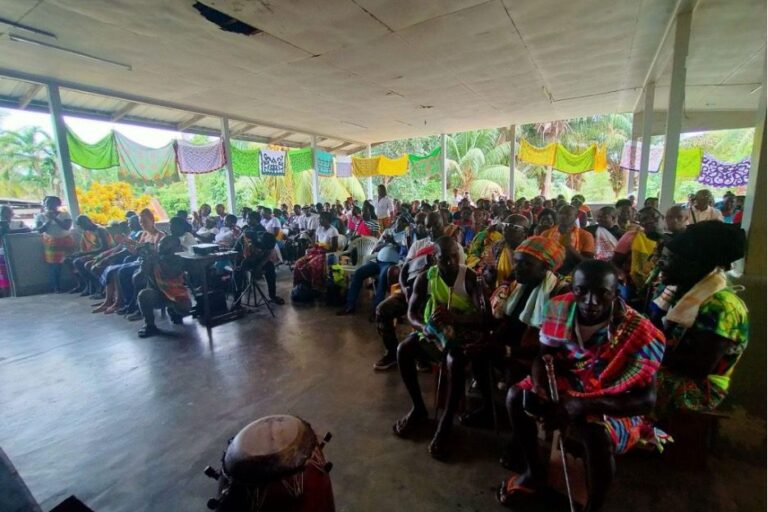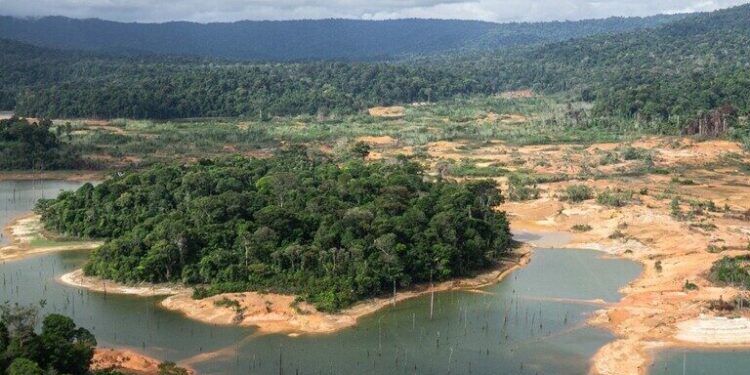Despite its environmental track record, Suriname is still the only country in South America that hasn’t formally recognized the territorial rights of Indigenous and Maroon peoples.The Saamaka claim that a 2007 ruling by the Inter-American Court of Human Rights should give them collective land rights, yet the government continues to grant forestry and mining concessions on their land.The Surinamese government has granted 447,000 hectares (1.1 million acres) of concessions on Saamaka land, or 32% of the territory, according to the International Land Coalition.In a letter to the president this month, Saamaka communities asked the government to stop granting land concessions and to officially demarcate their territory.
Suriname has some of the largest, most intact rainforests in the world. The Amazon covers around 93% of its surface area, making it one of the only countries with a net-negative carbon footprint. But at the same time, timber and mining concessions are expanding through the forest, with multinational companies moving in on Indigenous lands.
Despite its environmental track record, Suriname is still the only country in South America that hasn’t formally recognized the territorial rights of Indigenous and Maroon peoples trying to conserve the rainforest. Years of legal challenges have stalled, and the government continues to advance projects that threaten widespread deforestation and pollution.
“[Indigenous groups] have endured historical injustices and ongoing challenges in defending their forests and their rights from commercial logging and mining, which are increasingly weakening their legal capacity to control and manage their forests sustainably,” the International Land Coalition (ILC), an alliance of groups advocating land governance, said a recent report.
At the center of the fight are the Saamaka peoples, who occupy 1.4 million hectares (3.5 million acres) of land, 80% of which is still untouched forest. The Afro-descendent Saamaka, whose ancestors escaped slavery by moving into the forest, are made up of six tribal groups and represent about a fifth of the country’s total population.
A Saamaka woman in Suriname. Photo by Riano Gunther/ILC
In 2007, the Inter-American Court of Human Rights (IACHR) ordered the government to demarcate Saamaka territory according to ancestral claims, with the goal of giving them control over the area. It also ordered the distribution of wealth from state-run activities to local communities and the implementation of social and environmental impact assessments for all future projects. And while the government has followed through on parts of those orders, it’s also delayed many others while continuing to grant logging and mining concessions.
More than a decade since the ruling, the government has commissioned an official map of Saamaka territory but stopped short of legalizing it. Officials say that only parliament can do that, through a collective land rights law. Right now, however, there aren’t enough votes to push through such legislation.
In the meantime, that means the government can grant commercial logging concessions within Saamaka territory, claiming there’s no way to know whether the land is inside or out of the ancestral borders.
The government has granted 447,000 hectares (1.1 million acres) of concessions on Saamaka land, or 32% of the territory, according to the ILC. Nearly 40,855 hectares (100,954 acres) of that has come since the 2007 ruling.
Around 77% of all negative impacts on Saamaka land have occurred since the 2007 ruling, ILC found.
“Our land rights are constantly violated by international entities,” Hugo Jabini, adviser and project coordinator for the Association of Saamaka Communities, told Mongabay. “More logging, more mining companies who invade our territory with the permission of the Surinamese government — because it’s the government that provides the licenses to these companies for large-scale economic activities in our territory without our consent.”
Last year, Mongabay published documents showing government plans to develop agriculture and livestock on as much as 560,000 hectares (1.38 million acres) of land, much of it overlapping with primary forest on Saamaka territory. Last month, a court paused the plans until local communities’ rights could be better considered.
 A Saamaka community meeting. Photo by Riano Gunther/ILC
A Saamaka community meeting. Photo by Riano Gunther/ILC
In 2022, Malaysian logging company Palmera Hout allegedly started building a 42.7-kilometer (26.5-mile) road through Saamaka territory without conducting a complete prior consultation, a process in which the company meets with residents to discuss how the project would impact their lives.
Residents petitioned the government to halt construction of a bridge over the Suriname River connected to the road project. Although they were successful, the company and other loggers are now allegedly using a ferry to bring in construction materials and carry out timber.
Palmera Hout couldn’t be reached for a request for comment. The Ministry of Spatial Planning and the Environment didn’t reply to Mongabay’s request.
“That was an [area] our ancestors kept safe as a pristine forest,” Jabini said, “where we could enter any time to collect what we needed to survive for cultural reasons and many other things. And now they grant permissions to this multinational company and, in six months, they build an illegal road.”
Last year saw Saamaka communities increase their efforts to organize and combat development plans. They started sharing images and messages over WhatsApp with community leaders, which sparked a meeting of more than 500 people to discuss potential legal actions and fundraising.
This week, the Association of Saamaka Communities submitted a petition to President Chandrikapersad Santokhi asking that all logging activities along the road be stopped. It also asked for a consultation process and a social and environmental impact study of the road.
The petition reiterated the need for collective land ownership rights so that the Saamaka have the autonomy to sustainably manage the forest. It also called on the international community for support in their fight to win their territorial rights.
In its report, the ILC said it was vital that the Saamaka receive international support, noting that increased pressure from human rights and land advocacy groups could help hold the Surinamese government accountable for environmental commitments to conserve the rainforest, such as those made in the Paris Agreement and Leaders’ Pledge for Nature.
“We want to keep our biodiversity, our forests and show that we can keep contributing to the world with healthy air and our carbon,” Jabini said, “and make sure that we keep our status as one of the greenest countries with a carbon negative status.”
Banner image: The impacts of gold mining on the rainforest in Suriname. Photo by Bram Ebus/ILC.
See related from this reporter:
Landmark ruling in Suriname grants protections to local and Indigenous communities — for now
FEEDBACK: Use this form to send a message to the author of this post. If you want to post a public comment, you can do that at the bottom of the page.
Activism, Conservation, Deforestation, Environment, Environmental Law, Environmental Politics, Forests, Gold Mining, Governance, Indigenous Peoples, Indigenous Rights, Logging, Mining, Pollution, Protected Areas, Rainforests, Threats To Rainforests
South America, Suriname
Source link : https://news.mongabay.com/2024/07/as-logging-booms-in-suriname-forest-communities-race-to-win-land-rights/
Author :
Publish date : 2024-07-04 13:07:25
Copyright for syndicated content belongs to the linked Source.




